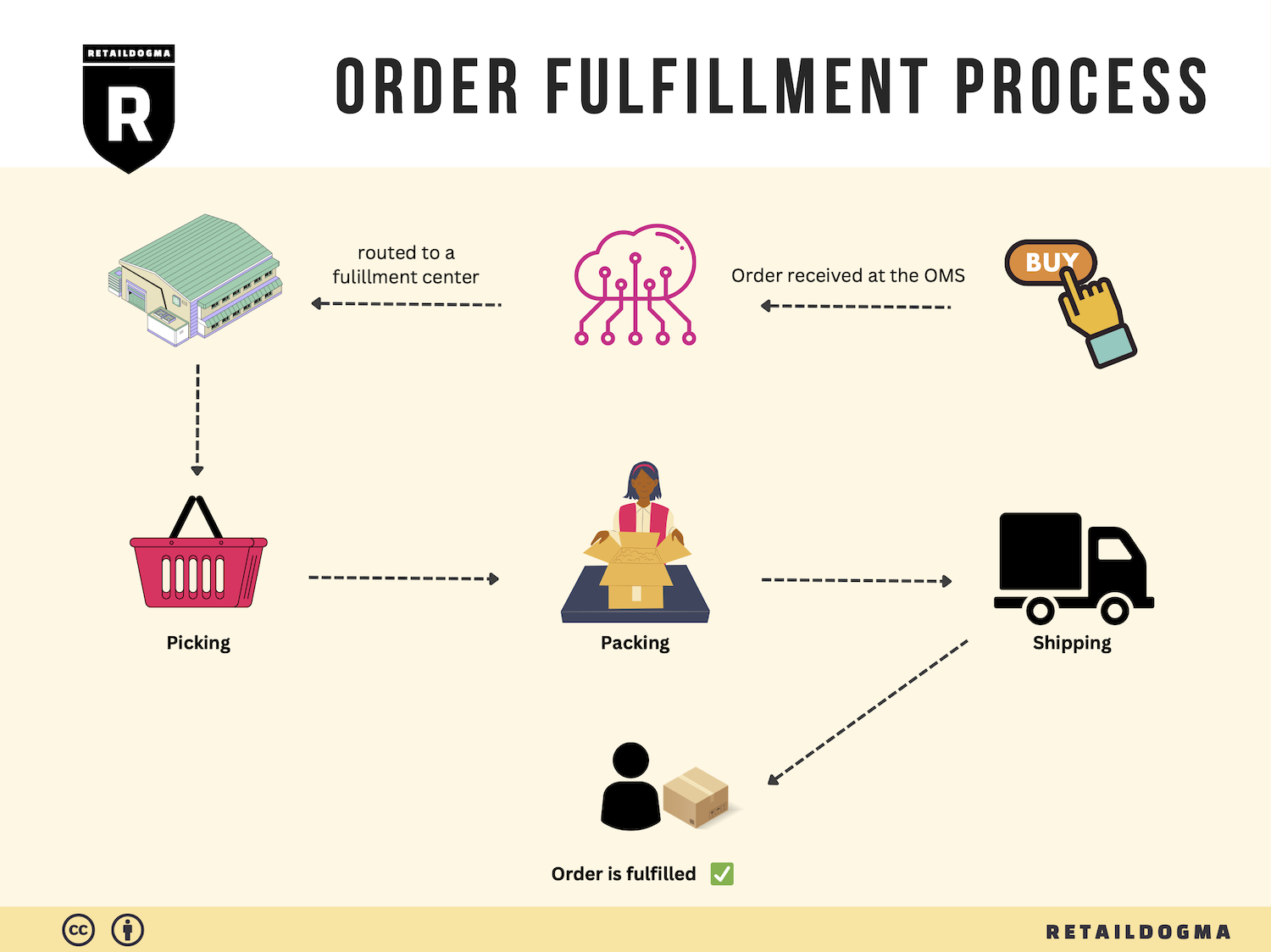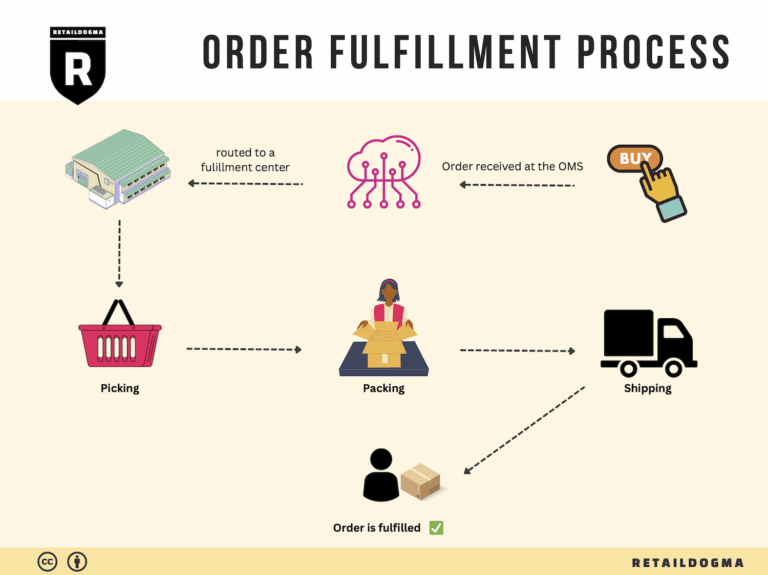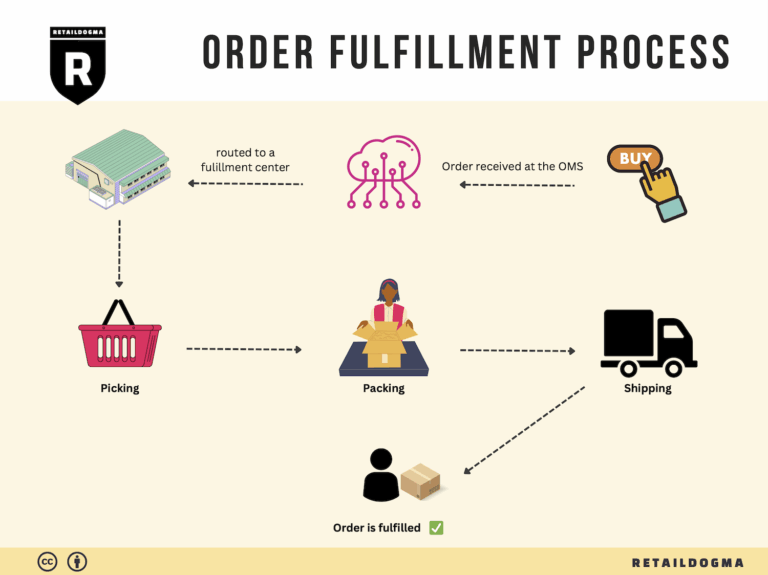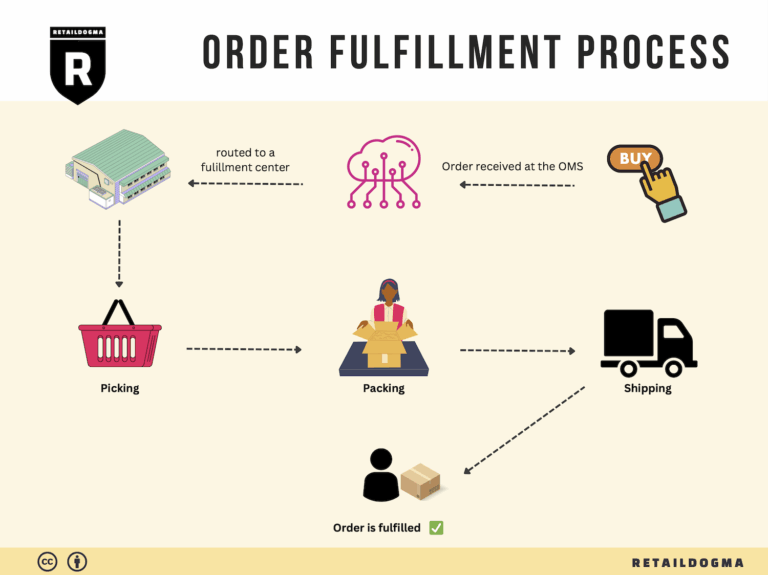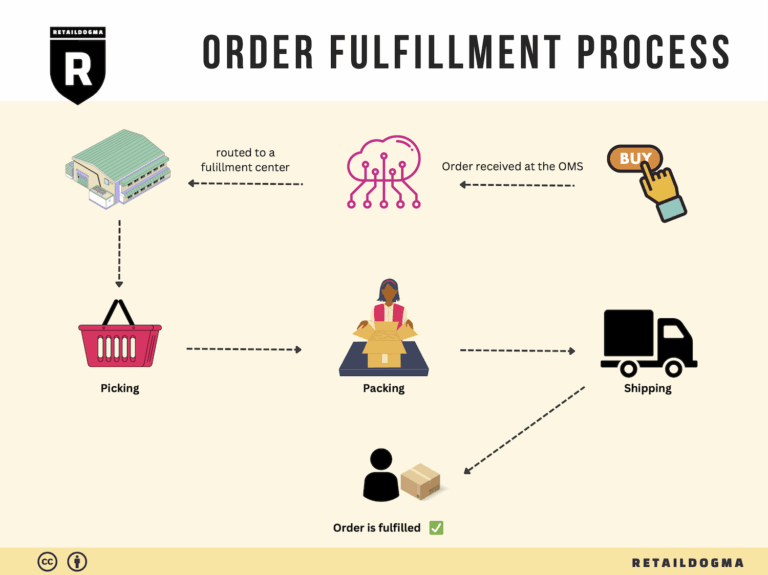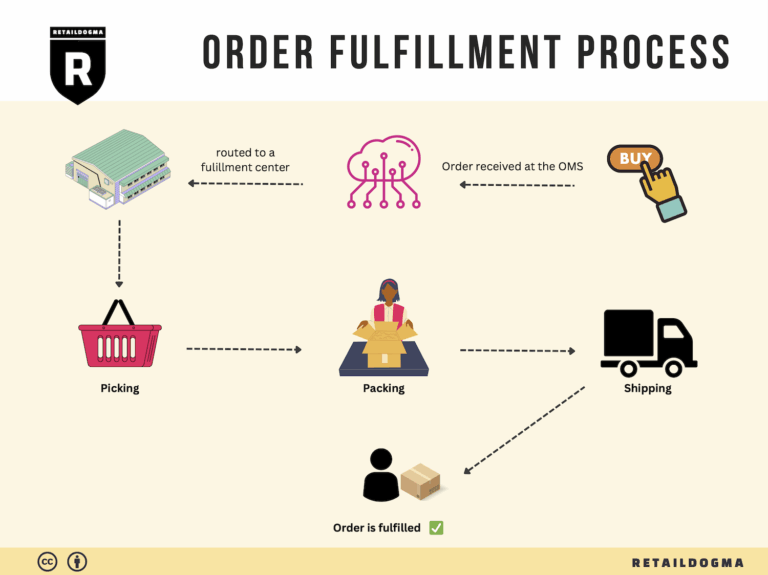What Is A Fulfillment Center? A Complete Guide (2025)
What is E-commerce Fulfillment? An Introduction for Growing Businesses
Understanding E-commerce Fulfillment
As an e-commerce business owner, you may often find yourself grappling with the complexities of packing and shipping orders. Managing inventory, ensuring timely deliveries, and maintaining a positive customer experience can quickly become overwhelming. This is where e-commerce fulfillment steps in to alleviate the burden. Simply put, fulfillment is the process of getting a product from your warehouse or fulfillment center to your customer’s doorstep. It encompasses everything from receiving inventory, storing products, picking and packing orders, to shipping them out and handling returns.
In this guide, we will delve into the various fulfillment models available for growing businesses, including Third-Party Logistics (3PL) and Fulfillment by Amazon (FBA). Understanding these options is crucial as each model comes with its own set of advantages and challenges. For instance, 3PL providers offer flexibility and can scale with your business, while FBA integrates seamlessly with the Amazon ecosystem, providing access to Amazon’s vast customer base but at a cost.
We will also explore the core services involved in e-commerce fulfillment. This includes inventory management, order processing, packing, shipping, and returns management. Each of these components plays a vital role in delivering a seamless customer experience and maintaining operational efficiency. Knowing what services are essential for your business will help you identify the right fulfillment partner.
Choosing the right fulfillment partner can make or break your e-commerce success. We will guide you through the key factors to consider when selecting a fulfillment provider, such as their location, technology, customer service, and scalability. These factors are critical in ensuring that your logistics operations align with your business goals.
Pricing is another essential aspect we will cover. Understanding the cost structure of fulfillment services, including storage fees, shipping costs, and any additional charges, will help you budget effectively and maintain healthy profit margins.
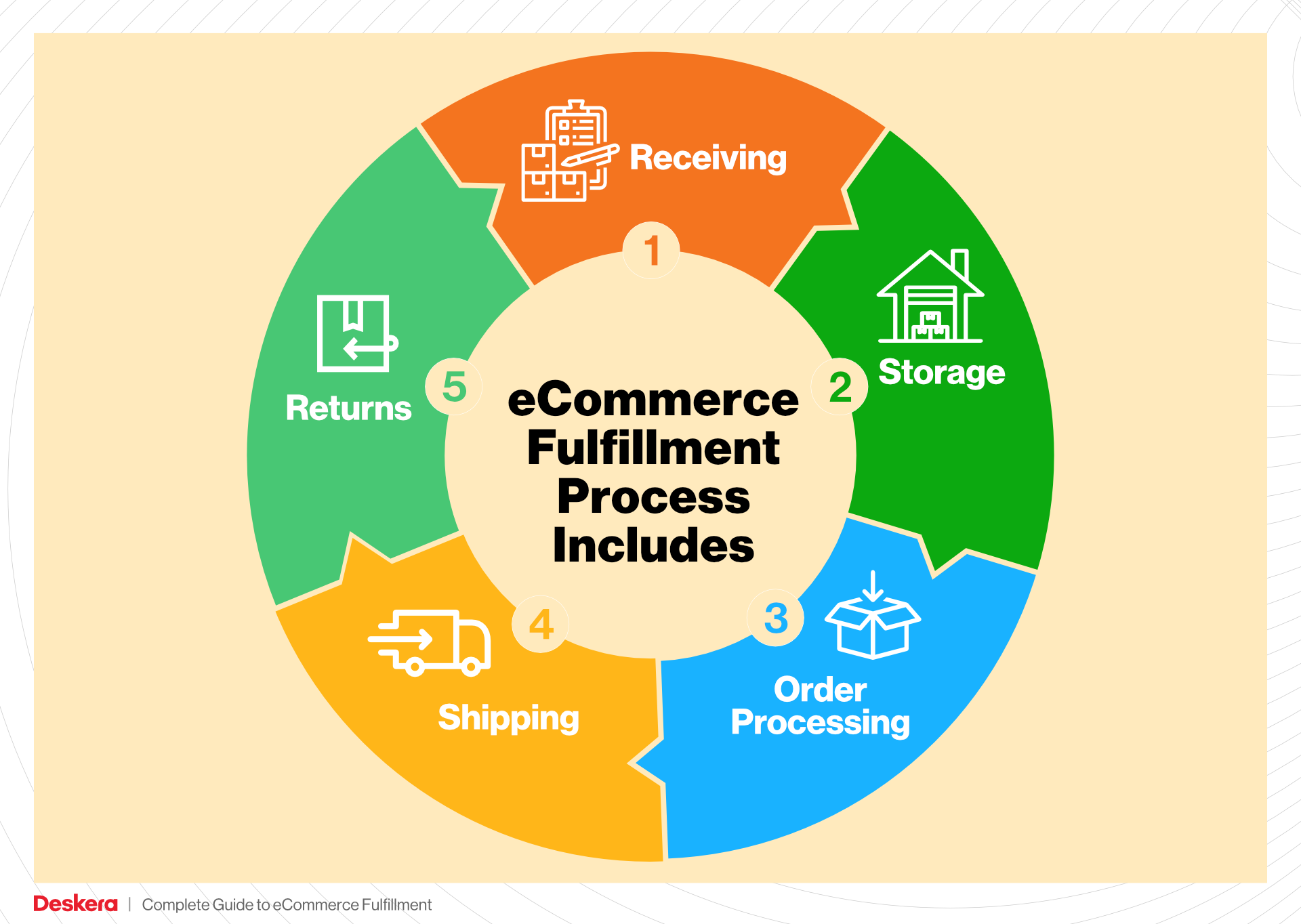
Ultimately, this guide aims to empower you to make informed decisions regarding your logistics and fulfillment strategies. By understanding the landscape of e-commerce fulfillment, you can streamline your operations, enhance customer satisfaction, and position your business for scalable growth.
What You’ll Learn In This Guide
- What is E-commerce Fulfillment? An Introduction for Growing Businesses
- The Order Fulfillment Process: From ‘Buy’ Button to Customer’s Door
- Comparing Fulfillment Models: In-House vs. 3PL vs. Dropshipping
- A Deep Dive into Amazon FBA: Pros, Cons, and Who It’s For
- Core Services Offered by Fulfillment Centers
- How to Choose a Fulfillment Partner: A 6-Point Checklist
- Understanding Fulfillment Pricing: A Breakdown of Common Fees
- Frequently Asked Questions (FAQs) about Fulfillment
- Conclusion: Is Outsourcing Fulfillment the Right Move for Your Business?
- Important Disclaimer
The Order Fulfillment Process: From ‘Buy’ Button to Customer’s Door
1. Receiving Inventory
The first step in the order fulfillment process is receiving inventory. This involves the acceptance of goods from suppliers or manufacturers into the fulfillment center. When inventory arrives, it is checked against purchase orders to ensure accuracy. This step is crucial because it establishes the foundation for inventory management and ensures that the warehouse has the correct products on hand.
Key Term: SKU (Stock Keeping Unit) – Each product is assigned a unique SKU, which facilitates tracking and management of inventory. Accurate receiving processes help maintain optimal stock levels, reduce discrepancies, and prevent stockouts or overstock situations, ultimately improving customer satisfaction.
2. Warehouse Storage
Once the inventory is received and verified, it is then organized within the warehouse. Proper storage is vital to ensure quick access and efficient order fulfillment. Products are categorized and placed in designated storage locations based on factors such as size, weight, and sales velocity. This systematic approach not only maximizes space utilization but also streamlines the picking process.
Key Term: ABC Analysis – This inventory categorization technique divides items into three categories (A, B, and C) based on their importance and turnover rates. ‘A’ items are high-value with a low frequency of sales, while ‘C’ items are low-value but high frequency. Understanding these categories helps businesses prioritize storage and retrieval efforts, ensuring that high-demand items are easily accessible.
3. Order Picking
When a customer places an order, the next step is order picking. This involves selecting the right items from their storage locations to fulfill the order. Efficiency in picking is critical, as it directly impacts order processing time and shipping speed. Various picking methods can be employed, such as single order picking, batch picking, or wave picking, depending on the volume and nature of orders.
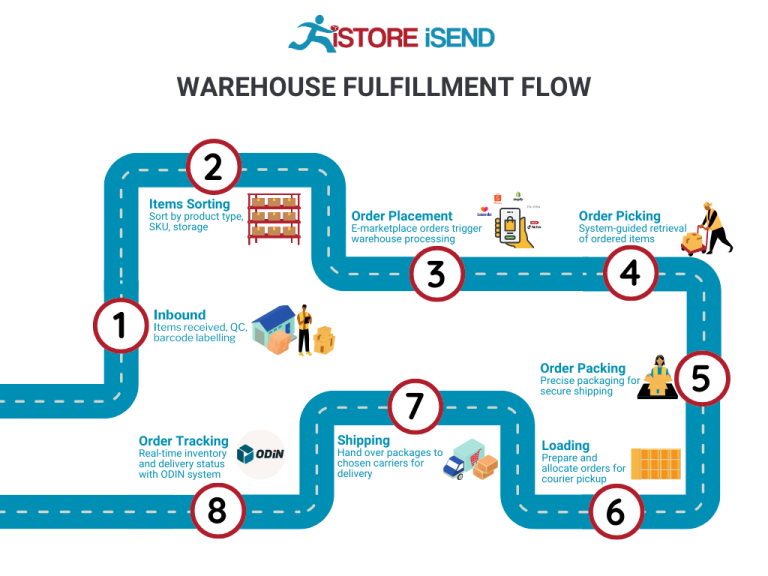
Key Term: Pick Lists – A pick list is a document or digital interface that outlines the items and quantities needed to fulfill a specific order. Using a pick list not only helps ensure accuracy but also guides warehouse staff through the most efficient route for gathering products, thus reducing labor costs and improving overall fulfillment speed.
4. Order Packing
After items are picked, they move to the packing station where they are prepared for shipment. Packing is an essential step that involves securely placing products into boxes, adding protective materials, and labeling packages for delivery. This process ensures that items arrive at the customer’s doorstep in good condition.
Key Term: Packing Slip – A packing slip is a document that accompanies the shipment and lists the items included in the package. It serves both as a receipt for the customer and a verification tool for the fulfillment center. Proper packing reduces the likelihood of damage during transit and enhances the overall customer experience, as it reflects the quality and care taken by the business.
5. Shipping & Delivery
The final step in the order fulfillment process is shipping and delivery. Once packages are packed, they are labeled and handed over to carriers for transport. Efficient shipping practices are crucial to meet customer expectations for delivery speed and reliability. Businesses often work with multiple carriers to optimize costs and service levels.
Key Term: Last-Mile Delivery – This term refers to the final leg of the shipping process where the package is delivered from a distribution center to the customer’s doorstep. The last-mile segment is often the most complex and expensive part of the shipping process, making it vital for businesses to explore various strategies (such as utilizing local couriers or implementing technology for tracking) to enhance efficiency and customer satisfaction.
By understanding and optimizing each step of the order fulfillment process, e-commerce businesses can not only improve their operational efficiency but also significantly enhance customer satisfaction, leading to increased loyalty and sales growth.
Comparing Fulfillment Models: In-House vs. 3PL vs. Dropshipping
Fulfillment Model Comparison
| Model | Who Handles Inventory | Best For (Business Stage) | Key Advantage | Key Disadvantage |
|---|---|---|---|---|
| In-House Fulfillment | Business itself | Established businesses | Full control over operations | High overhead costs |
| Third-Party Logistics (3PL) | External logistics provider | Growing businesses | Scalability and flexibility | Less control over inventory |
| Dropshipping | Supplier | Startups and small businesses | Low startup costs and risk | Lower profit margins |
In-House Fulfillment
In-house fulfillment involves a business managing its own inventory and logistics operations. This model is typically adopted by established businesses that have the resources and infrastructure to handle order processing, inventory management, and shipping. The key advantage of in-house fulfillment is that it provides full control over the entire fulfillment process, allowing businesses to maintain quality standards and brand consistency. However, this comes with significant disadvantages, such as higher overhead costs related to warehousing, staffing, and technology investments. Businesses must also manage the complexities of logistics, which can be time-consuming and require specialized knowledge. For companies looking to maintain a strong connection with their supply chain and customer service, in-house fulfillment can be an effective strategy, but it requires a robust operational framework.
Third-Party Logistics (3PL)
Third-party logistics (3PL) providers handle the storage, fulfillment, and shipping of products on behalf of businesses. This model is particularly beneficial for growing companies that need to scale their operations without investing heavily in their own logistics infrastructure. By partnering with a 3PL, businesses can leverage the provider’s expertise, technology, and resources, allowing them to focus on core competencies such as product development and marketing. The key advantage of using a 3PL is the scalability and flexibility it offers; as demand fluctuates, businesses can easily adjust their logistics requirements without the burden of managing excess inventory or warehouse space. However, the downside is that businesses may have less control over their inventory and fulfillment processes, which can lead to inconsistencies in customer service and brand experience. Choosing the right 3PL partner is crucial, as it can impact delivery times, costs, and overall customer satisfaction.
Dropshipping
Dropshipping is a fulfillment method where the retailer does not keep products in stock but instead transfers customer orders to a supplier, who then ships the products directly to the customer. This model is ideal for startups and small businesses that want to minimize upfront investment and operational risk. The primary advantage of dropshipping is the low barrier to entry; entrepreneurs can start an e-commerce store without the need for significant capital to purchase inventory or manage warehouse space. This allows for a wide range of products to be offered without the financial risk associated with unsold inventory. However, dropshipping also presents challenges, particularly in terms of profit margins, which are often lower due to the reliance on third-party suppliers. Additionally, businesses have limited control over product quality, shipping times, and customer service, which can affect the overall customer experience. For those looking to enter the e-commerce space with minimal risk, dropshipping can be a viable option, but it requires careful supplier selection and management to ensure a positive customer experience.
By understanding these different fulfillment models, e-commerce business owners can make informed decisions about which approach best aligns with their operational capabilities, business stage, and growth ambitions. Each model has its unique advantages and disadvantages, and the choice ultimately depends on the specific needs and goals of the business.
A Deep Dive into Amazon FBA: Pros, Cons, and Who It’s For
Understanding Fulfillment by Amazon (FBA)
Fulfillment by Amazon (FBA) is a service offered by Amazon that allows sellers to store their products in Amazon’s fulfillment centers. Amazon then takes care of storage, packaging, shipping, and customer service on behalf of the sellers. This service is designed to simplify the logistics process for e-commerce businesses, enabling them to focus on growth and customer engagement rather than the complexities of order fulfillment.
How FBA Works
-
Product Listing and Inventory: Sellers create product listings on Amazon and send their inventory to Amazon’s fulfillment centers. This can be done in bulk or as needed, depending on the seller’s strategy.
-
Storage: Once the products arrive at the fulfillment center, they are stored until they are sold. Amazon manages the inventory and keeps track of stock levels.
-
Order Fulfillment: When a customer places an order for a product, Amazon handles the entire fulfillment process. This includes picking the product from the shelves, packing it, and shipping it directly to the customer.
-
Customer Service: Amazon also provides customer service for the products sold through FBA, handling inquiries, returns, and refunds, which alleviates a significant burden from sellers.
-
Returns Management: In the event of a return, Amazon manages the return process, making it easier for customers and sellers alike.
Pros of Fulfillment by Amazon
-
Prime Eligibility: Products fulfilled by Amazon are eligible for Amazon Prime, giving sellers access to millions of Prime members who prefer fast and free shipping options. This can significantly boost sales and visibility.

-
Customer Trust: Leveraging Amazon’s brand recognition and customer service can enhance trust among potential buyers. Customers feel more secure purchasing items backed by Amazon’s return policies and customer support.
-
Multi-Channel Fulfillment: FBA allows sellers to fulfill orders from other sales channels, such as their own website or eBay, using Amazon’s logistics network. This expands the reach of sellers while simplifying their fulfillment process.
-
Scalability: With Amazon handling logistics, sellers can scale their business more easily. They can increase inventory without worrying about the complexities of warehousing and shipping.
-
Time Savings: By outsourcing fulfillment to Amazon, sellers save considerable time that can be redirected toward marketing, product development, and other growth strategies.
-
Advanced Logistics and Technology: Amazon uses advanced technology and logistics systems, which means sellers benefit from sophisticated inventory management and shipping processes that they might not be able to replicate independently.
Cons of Fulfillment by Amazon
-
High Fees: FBA comes with various fees, including storage fees and fulfillment fees that can add up quickly. For sellers with lower margins, these costs can significantly cut into profits.
-
Strict Inventory Rules: Amazon has strict inventory management policies that sellers must adhere to. These include limits on the number of units that can be stored and requirements for inventory performance metrics. Sellers must constantly monitor and manage their stock levels to avoid penalties.
-
Commingling Risks: FBA products may be commingled, meaning that inventory from multiple sellers could be stored together. This can lead to issues with quality control, as sellers may receive returns or complaints about products that are not theirs.
-
Loss of Control: By using FBA, sellers relinquish control over the fulfillment process. They must rely on Amazon’s systems and processes, which may not always align with their operational preferences.
-
Potential for Stockouts: If a seller’s inventory runs low or is not replenished in time, they risk stockouts, which can negatively impact sales and ranking on the Amazon platform.
-
Limited Customization: FBA does not allow for much customization in packaging or branding, which can be a drawback for brands looking to create a unique customer experience.
Who is FBA Best For?
Fulfillment by Amazon is best suited for:
-
Small to Medium-Sized Businesses: Companies that lack the infrastructure or resources to manage their own fulfillment can benefit significantly from FBA’s logistics support.
-
E-commerce Sellers with High Volume: Sellers with a high volume of sales can take advantage of FBA to streamline their operations and maximize efficiency.
-
Brands Seeking Rapid Growth: Businesses looking to scale quickly can leverage FBA to expand their reach without the overhead costs associated with warehousing and shipping.
-
Sellers Focused on Customer Experience: Companies that prioritize customer satisfaction and trust may find FBA appealing due to Amazon’s established reputation and customer service excellence.
-
Multi-Channel Sellers: Those who sell across various platforms can benefit from the multi-channel fulfillment capabilities of FBA, allowing for a cohesive logistics strategy.
In conclusion, while FBA offers numerous advantages that can facilitate growth and enhance customer trust, it is essential for sellers to carefully weigh the costs and operational implications. By understanding both the benefits and drawbacks, e-commerce business owners can make informed decisions on whether FBA aligns with their business goals and logistics needs.
Core Services Offered by Fulfillment Centers
Inventory Management & Warehousing
Inventory management and warehousing are foundational services provided by fulfillment centers, crucial for the smooth operation of any e-commerce business. This service involves the systematic storage of products in a controlled environment, where inventory levels are monitored and managed efficiently.
Fulfillment centers utilize advanced inventory management systems that track stock levels in real-time, ensuring that businesses have accurate visibility into their inventory. This capability allows e-commerce operators to avoid stockouts or overstock situations, which can lead to lost sales or increased holding costs, respectively.
The benefits of effective inventory management are significant. It helps businesses maintain optimal stock levels, reduce carrying costs, and improve cash flow. By outsourcing these tasks to a fulfillment center, e-commerce businesses can focus on core activities like marketing and product development, knowing their inventory is in capable hands. Furthermore, many fulfillment centers offer specialized warehousing solutions, such as climate-controlled environments for sensitive products, further enhancing the service.
Pick and Pack Services
Pick and pack services are critical for e-commerce fulfillment, as they directly impact order accuracy and delivery speed. This process involves selecting items from inventory (picking) and preparing them for shipment (packing). Fulfillment centers employ streamlined processes and technology, such as barcode scanning and automated picking systems, to ensure that orders are fulfilled accurately and efficiently.
The benefits of pick and pack services are manifold. First, they enhance order accuracy, which is vital for customer satisfaction. Errors in order fulfillment can lead to returns, exchanges, and negative reviews, all of which can harm a business’s reputation. By utilizing a fulfillment center’s pick and pack services, e-commerce businesses can significantly reduce these risks.
Additionally, these services can improve shipping speed. Fulfillment centers often have optimized layouts and trained staff who can pick and pack orders quickly. This speed not only enhances customer satisfaction through faster delivery times but also allows businesses to scale operations without the need for significant investments in infrastructure or personnel.
Kitting and Assembly
Kitting and assembly services are essential for e-commerce businesses that sell products requiring assembly or bundling. This process involves grouping individual items into ready-to-ship kits or assembling components into a final product. Fulfillment centers can handle complex kitting and assembly tasks, ensuring that products are packaged correctly and meet customer expectations.
The primary benefit of kitting and assembly services is that they simplify the fulfillment process for e-commerce businesses. By outsourcing these tasks, businesses can streamline their operations and reduce the time it takes to prepare products for sale. This efficiency can be particularly beneficial during peak seasons when demand surges.
Moreover, kitting can enhance the perceived value of a product. For example, offering a bundled kit of related items can encourage customers to purchase more than they originally intended. This strategy can lead to increased sales and improved customer satisfaction, as customers appreciate the convenience of receiving a complete solution in one package.
Returns Management (Reverse Logistics)
Returns management, or reverse logistics, is a crucial service offered by fulfillment centers, particularly in the e-commerce landscape where return rates can be high. This service involves handling returned products efficiently, from receiving the return to restocking the items or disposing of them when necessary.
The benefits of effective returns management are substantial. A well-managed return process can enhance customer loyalty, as customers are more likely to return to a business that offers hassle-free returns. Fulfillment centers typically have established processes for inspecting returned items, determining their condition, and deciding the best course of action, whether that be restocking, refurbishing, or recycling.
Additionally, efficient returns management can provide valuable insights into product performance and customer preferences. By analyzing return data, businesses can identify trends that may indicate issues with product quality or sizing, allowing them to make informed decisions about inventory and product development. This proactive approach not only improves the overall customer experience but can also lead to reduced return rates in the long run.
In conclusion, partnering with a fulfillment center for these core services allows e-commerce businesses to enhance operational efficiency, improve customer satisfaction, and scale their operations effectively. By leveraging the expertise and resources of fulfillment centers, businesses can focus on growth and innovation while ensuring that their logistics and fulfillment processes are in capable hands.
How to Choose a Fulfillment Partner: A 6-Point Checklist
Location & Warehouse Network
Importance:
The geographical location of your fulfillment partner’s warehouses can significantly impact shipping times and costs. A partner with warehouses strategically placed near your customer base can help you offer faster delivery options, thereby improving customer satisfaction and retention.
Questions to Ask:
– Where are your fulfillment centers located, and how do they align with my target market?
– Do you have a network of warehouses that can support multi-channel distribution?
– How do you handle shipping to remote or less accessible areas?
Technology & Integrations
Importance:
The technology used by your fulfillment partner can streamline operations, improve accuracy, and enhance visibility throughout the supply chain. A partner that offers robust integration capabilities with your existing e-commerce platform can save time and reduce errors.
Questions to Ask:
– What warehouse management system (WMS) do you use, and how does it support inventory tracking and order management?
– Can your systems integrate with my e-commerce platform (e.g., Shopify, WooCommerce, Amazon)?
– Do you offer real-time tracking and reporting capabilities for my shipments?
Specializations (e.g., Cold Storage, Oversized Items)
Importance:
Depending on your product types, it may be essential to partner with a fulfillment center that specializes in certain categories, such as cold storage for perishables or handling oversized items. This ensures that your products are stored and shipped under optimal conditions.
Questions to Ask:
– Do you have specialized facilities for my product type (e.g., refrigerated storage, hazardous materials)?
– What processes do you have in place to manage unique product requirements?
– How do you ensure compliance with industry regulations related to my products?
Scalability & Capacity
Importance:
As your business grows, your fulfillment needs will likely change. A partner with scalable solutions can accommodate your growth without sacrificing service quality. Ensuring that your partner has the capacity to handle seasonal spikes in demand is also crucial.
Questions to Ask:
– How do you manage capacity during peak seasons?
– Can you scale up operations to accommodate rapid growth or unexpected demand surges?
– What is your process for onboarding new clients or expanding services as needed?
Pricing and Contracts
Importance:
Understanding the pricing structure of your fulfillment partner is critical for budgeting and forecasting. Transparent pricing can help you avoid unexpected costs that could erode your profit margins.
Questions to Ask:
– What are your pricing models (e.g., per order, monthly fees, storage fees)?
– Are there any additional fees for services like returns processing or special handling?
– How flexible are your contracts in terms of duration and exit options?
Customer Support & Reviews
Importance:
Effective customer support is crucial for resolving issues quickly and maintaining a smooth operation. Additionally, reviews and testimonials can provide insight into a partner’s reliability and service quality.
Questions to Ask:
– What customer support options do you offer (e.g., phone, email, chat), and what are your response times?
– Can you provide references or case studies from businesses similar to mine?
– How do you handle customer complaints or operational issues?
Conclusion
Choosing the right fulfillment partner is a critical decision that can significantly impact your e-commerce business’s success. By using this checklist, you can evaluate potential partners based on key criteria that align with your operational needs and growth objectives. Remember that the right partner not only enhances your logistics but also contributes to your overall customer experience. Prioritize finding a partner that shares your commitment to quality and efficiency, ensuring a successful long-term collaboration.
Understanding Fulfillment Pricing: A Breakdown of Common Fees
Initial Setup Fees
When partnering with a fulfillment center, initial setup fees are often the first cost you encounter. These fees typically cover the onboarding process, which may include account setup, system integration, and training your staff on the fulfillment processes. The amount can vary based on the complexity of your needs and the technology used by the fulfillment center.
Calculating this fee involves assessing the specific services you require. For example, if you need advanced integrations with your e-commerce platform or custom software solutions, the setup fee may be higher. To minimize these costs, consider standardizing your operations and choosing fulfillment centers that offer streamlined onboarding processes.
Receiving Fees
Receiving fees are charged when your inventory arrives at the fulfillment center. This fee covers the labor and resources needed to unload, inspect, and store your products. It is generally calculated based on the volume or weight of your shipment, or it may be a flat fee per pallet received.
To manage receiving fees effectively, ensure that your shipments are well-organized and labeled. This can speed up the receiving process, which may help reduce overall costs. Additionally, consider timing your shipments strategically to avoid peak periods when receiving costs may be higher due to increased demand on labor and resources.
Storage Fees (per pallet/bin)
Storage fees are incurred for keeping your inventory in the fulfillment center. These fees are typically charged on a monthly basis and can be calculated per pallet or per bin. The cost is influenced by factors such as the size of the products and the duration of storage. Some fulfillment centers may offer tiered pricing based on the volume of inventory stored.
To optimize storage costs, regularly analyze your inventory turnover rates. If certain products are not selling, consider discounting them or finding alternative storage solutions. Additionally, inquire about seasonal pricing adjustments, as some fulfillment centers may offer lower rates during off-peak seasons.
Pick & Pack Fees (per item/order)
Pick and pack fees are charged for the labor involved in retrieving items from storage and packaging them for shipment. This fee can be calculated on a per item or per order basis. The complexity of the order, including the number of items and the packaging requirements, will influence the total cost.
To reduce pick and pack fees, streamline your product offerings and minimize the variety of SKUs you manage. This can simplify the picking process. Furthermore, consider using standard packaging materials to lower costs associated with custom packaging solutions.
Shipping Fees
Shipping fees are incurred when your products are sent out to customers. These fees vary widely based on factors such as the shipping method (standard, expedited, etc.), the destination, and the weight or dimensions of the package. Fulfillment centers often have partnerships with shipping carriers, which can provide discounted rates that you may benefit from.
To manage shipping fees effectively, compare different shipping options and consider offering customers a range of choices at checkout. Additionally, analyzing your sales data can help you identify the most common shipping destinations, allowing you to negotiate better rates with carriers based on volume.
Conclusion: Tips for Getting an Accurate Quote
To obtain an accurate quote for fulfillment services, follow these practical tips:
-
Assess Your Needs: Clearly outline your business requirements, including expected order volume, product types, and storage needs.
-
Request Detailed Quotes: Ask fulfillment centers for itemized quotes that break down each fee type. This will help you understand where your costs are coming from.
-
Negotiate Terms: Don’t hesitate to negotiate fees, especially if you anticipate a long-term partnership or high order volumes.
-
Consider Hidden Costs: Be aware of potential hidden fees, such as those for returns, damaged items, or additional services like custom packaging.
-
Compare Multiple Providers: Obtain quotes from several fulfillment centers to ensure you are getting competitive pricing and services tailored to your business model.
By understanding these common fulfillment pricing models and following these tips, you can make informed decisions that will help you scale your e-commerce operations effectively.
Frequently Asked Questions (FAQs) about Fulfillment
1. What is the purpose of an Amazon fulfillment center tour?
The Amazon fulfillment center tour provides an opportunity for participants to gain insights into the processes, technology, and people behind Amazon’s order fulfillment operations. Attendees will see firsthand how items are picked, packed, and shipped, as well as learn about Amazon’s commitment to innovation and sustainability.
2. How long does the tour last?
Each tour typically lasts between 60 to 90 minutes. Participants will walk through various sections of the fulfillment center and may cover approximately one mile.
3. What should I wear for the tour?
Visitors are required to wear flat, closed-toed shoes and long pants for safety reasons. Shirts must have sleeves, and loose-fitting clothing or accessories are not permitted. It’s advisable to wear comfortable shoes, as the tour involves walking and navigating an active work environment.
4. Are there any age restrictions for the tour?
Yes, the minimum age for participation is 6 years old. Children under this age are not permitted on the tour. All minors must be accompanied by an adult, and there must be at least one adult for every ten minors.
5. What identification do I need to bring?
Guests must present a government-issued photo ID upon arrival. The information provided during registration must match the ID. Children under 18 are not required to show ID.
6. Can I take photographs during the tour?
No, personal cell phones are not allowed during the tour. Photography is only permitted in designated areas, such as the lobby. Guests should leave their phones in a secure location provided by the tour staff if they cannot leave them in a vehicle.
7. What is the difference between a warehouse and a fulfillment center?
A warehouse primarily serves as a storage facility for goods, whereas a fulfillment center is designed specifically for processing orders and shipping products directly to customers. Fulfillment centers often incorporate advanced technology and systems to streamline the picking, packing, and shipping processes.
8. What is a 3PL (Third-Party Logistics)?
A 3PL provider is a company that offers outsourced logistics services, including warehousing, fulfillment, and distribution. They manage the supply chain operations on behalf of businesses, allowing those companies to focus on their core competencies while benefiting from the expertise and resources of the 3PL.
9. How much do fulfillment services cost?
The cost of fulfillment services varies widely based on factors such as order volume, storage needs, and the specific services provided (like picking, packing, and shipping). Businesses should assess their needs and compare pricing from different fulfillment service providers to find the best fit for their budget.
10. How do I book a tour at the DEN3 fulfillment center?
To book a tour at the DEN3 fulfillment center in Thornton, Colorado, visit the Amazon Tours website and select your preferred date and time. Reservations are required, and new availability is typically released mid-month, so check back regularly if your desired date is not currently available.
Conclusion: Is Outsourcing Fulfillment the Right Move for Your Business?
Evaluating the Benefits of Outsourcing Fulfillment
Outsourcing fulfillment can be a transformative decision for e-commerce businesses looking to scale effectively. One of the most significant benefits is time savings. By partnering with a fulfillment service, you free up valuable hours that can be redirected towards strategic initiatives such as product development, marketing, and customer engagement. This shift allows business owners and operations managers to focus on growth rather than getting bogged down by logistics.
Another key advantage is scalability. As your business grows, so too do the complexities of managing inventory, shipping, and returns. Fulfillment partners typically have the infrastructure and resources to scale alongside your business, accommodating seasonal spikes in demand or expanding to new markets without the need for substantial upfront investment in warehousing or staffing.
Additionally, these partners offer expertise in logistics that can enhance your operational efficiency. With their advanced technology, streamlined processes, and experienced personnel, fulfillment centers can optimize shipping times and reduce errors, ultimately leading to improved customer satisfaction.
However, the importance of selecting the right fulfillment partner cannot be overstated. A partner that aligns with your business goals and values is crucial for long-term success. Factors such as reliability, technology integration, and customer service should play a significant role in your decision-making process.
Call to Action
To determine if outsourcing fulfillment is the right next step for your business, start by conducting a thorough audit of your current shipping processes. Evaluate your costs, time investment, and customer feedback. Consider whether a fulfillment partner could alleviate challenges and support your growth objectives. Making an informed choice now can set the stage for sustainable success in the future.
Important Disclaimer
⚠️ Important Disclaimer
The information in this guide is for educational purposes. Fulfillment services, pricing, and platform features change frequently. Always conduct your own due diligence and consult with providers directly before making business decisions.
